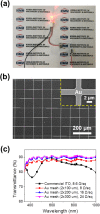13.2% efficiency Si nanowire/PEDOT:PSS hybrid solar cell using a transfer-imprinted Au mesh electrode
- PMID: 26174964
- PMCID: PMC4502511
- DOI: 10.1038/srep12093
13.2% efficiency Si nanowire/PEDOT:PSS hybrid solar cell using a transfer-imprinted Au mesh electrode
Abstract
In recent years, inorganic/organic hybrid solar cell concept has received growing attention for alternative energy solution because of the potential for facile and low-cost fabrication and high efficiency. Here, we report highly efficient hybrid solar cells based on silicon nanowires (SiNWs) and poly(3,4-ethylenedioxythiophene):poly(styrenesulfonate) (
Pedot: PSS) using transfer-imprinted metal mesh front electrodes. Such a structure increases the optical absorption and shortens the carrier transport distance, thus, it greatly increases the charge carrier collection efficiency. Compared with hybrid cells formed using indium tin oxide (ITO) electrodes, we find an increase in power conversion efficiency from 5.95% to 13.2%, which is attributed to improvements in both the electrical and optical properties of the Au mesh electrode. Our fabrication strategy for metal mesh electrode is suitable for the large-scale fabrication of flexible transparent electrodes, paving the way towards low-cost, high-efficiency, flexible solar cells.
Figures





Similar articles
-
Solution-processed highly conductive PEDOT:PSS/AgNW/GO transparent film for efficient organic-Si hybrid solar cells.ACS Appl Mater Interfaces. 2015 Feb 11;7(5):3272-9. doi: 10.1021/am508006q. Epub 2015 Jan 29. ACS Appl Mater Interfaces. 2015. PMID: 25599588
-
Embedded Metal Electrode for Organic-Inorganic Hybrid Nanowire Solar Cells.ACS Nano. 2017 Jun 27;11(6):6218-6224. doi: 10.1021/acsnano.7b02322. Epub 2017 May 25. ACS Nano. 2017. PMID: 28531350
-
High Efficiency Organic/Silicon-Nanowire Hybrid Solar Cells: Significance of Strong Inversion Layer.Sci Rep. 2015 Nov 27;5:17371. doi: 10.1038/srep17371. Sci Rep. 2015. PMID: 26610848 Free PMC article.
-
Performance-Enhancing Approaches for PEDOT:PSS-Si Hybrid Solar Cells.Angew Chem Int Ed Engl. 2021 Mar 1;60(10):5036-5055. doi: 10.1002/anie.201910629. Epub 2020 Oct 23. Angew Chem Int Ed Engl. 2021. PMID: 31840360 Review.
-
Research Progress on Polymer Solar Cells Based on PEDOT:PSS Electrodes.Polymers (Basel). 2020 Jan 7;12(1):145. doi: 10.3390/polym12010145. Polymers (Basel). 2020. PMID: 31936017 Free PMC article. Review.
Cited by
-
Hybrid Silicon Nanowire Devices and Their Functional Diversity.Adv Sci (Weinh). 2019 Jun 3;6(15):1900522. doi: 10.1002/advs.201900522. eCollection 2019 Aug 7. Adv Sci (Weinh). 2019. PMID: 31406669 Free PMC article. Review.
-
Solar Cell Based on Hybrid Structural SiNW/Poly(3,4 ethylenedioxythiophene): Poly(styrenesulfonate)/Graphene.Glob Chall. 2020 May 17;4(9):2000010. doi: 10.1002/gch2.202000010. eCollection 2020 Sep. Glob Chall. 2020. PMID: 32999734 Free PMC article.
-
Macro-scale transport of the excitation energy along a metal nanotrack: exciton-plasmon energy transfer mechanism.Sci Rep. 2019 Jan 14;9(1):98. doi: 10.1038/s41598-018-36627-2. Sci Rep. 2019. PMID: 30643185 Free PMC article.
-
Nanostructural Modification of PEDOT:PSS for High Charge Carrier Collection in Hybrid Frontal Interface of Solar Cells.Polymers (Basel). 2019 Jun 11;11(6):1034. doi: 10.3390/polym11061034. Polymers (Basel). 2019. PMID: 31212644 Free PMC article.
-
Improved Interfacial Contact for Pyramidal Texturing of Silicon Heterojunction Solar Cells.Molecules. 2022 Mar 5;27(5):1710. doi: 10.3390/molecules27051710. Molecules. 2022. PMID: 35268811 Free PMC article.
References
-
- Garnett E. C. & Yang P. Silicon nanowire radial p–n junction solar cells. J. Am. Chem. Soc. 130, 9224–9225 (2008). - PubMed
-
- Zhu J. et al. Optical absorption enhancement in amorphous silicon nanowire and nanocone arrays. Nano Lett. 9, 279–282 (2009). - PubMed
-
- Garnett E. C. & Yang P. Light trapping in silicon nanowire solar cells. Nano Lett. 10, 1082–1087 (2010). - PubMed
-
- Putnam M. C. et al. Si microwire-array solar cells. Energy Environ. Sci. 3, 1037–1041 (2010).
-
- Jung J.-Y. et al. A strong antireflective solar cell prepared by tapering silicon nanowires. Opt. Express 18, A286–A292 (2010). - PubMed
Publication types
LinkOut - more resources
Full Text Sources
Other Literature Sources

